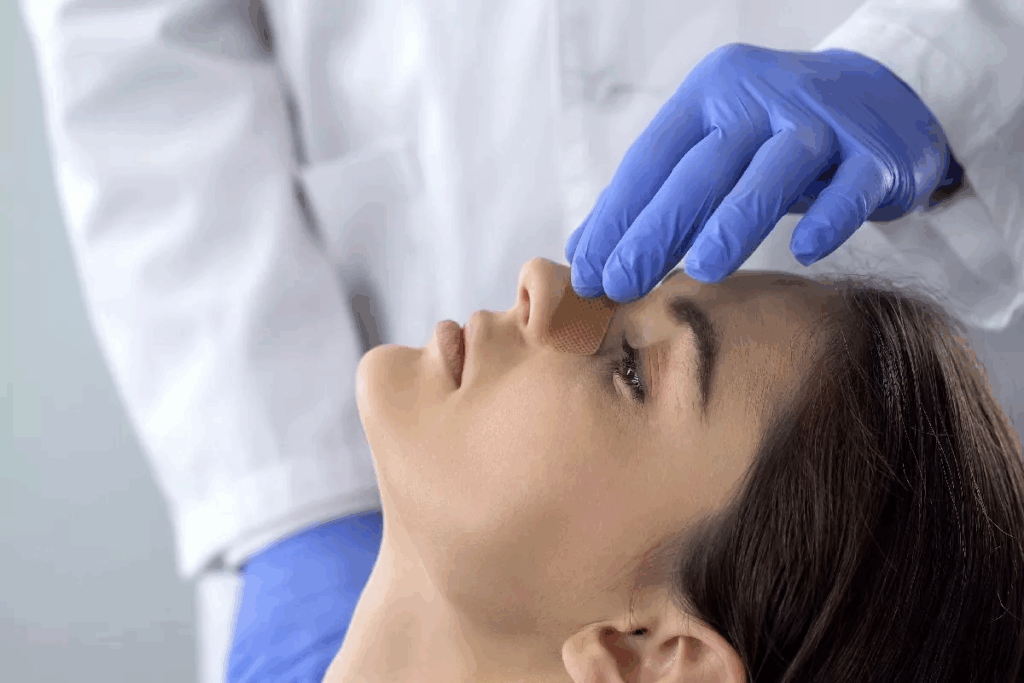
A deviated septum happens when the thin wall between the nasal passages shifts. This makes one passage smaller than the other. About 80 percent of people have some degree of nasal septum deviation. Often, they don’t notice it until symptoms show up.How can you tell if you have a deviated septum? A self-check guide based on symptoms like chronic congestion and one-sided nosebleeds.
Knowing if you have a deviated septum is key to getting the right treatment. We’ll show you how to spot the signs and do a simple self-test. This will help you decide if you need to see a doctor.

Many people don’t know they have a deviated septum. This is because small deviations often don’t show symptoms. A deviated septum happens when the thin wall between the nasal passages is off-center.
This can make one nostril smaller than the other. This can lead to breathing problems and other respiratory issues. Knowing about the nasal septum and how common deviated septums are is key to understanding and treating this condition.
The nasal septum is made of cartilage and bone. It divides the nasal cavity into two nostrils. If it’s off-center, it can block airflow unevenly. The Cleveland Clinic says a deviated septum makes one nostril smaller than the other.
Nasal Anatomy: The nasal cavity has many important parts:
Many people have some septal deviation, but not all show symptoms. Minor deviations are usually normal and don’t need medical help.
“Most people have some degree of nasal septum deviation, but it’s not always a cause for concern.” – ENT Specialist
Deviated septums can be born with or caused by injury. While significant deviations are rare, they can greatly affect your life.
Degree of Deviation | Symptoms | Medical Attention Required |
Minor | Asymptomatic | No |
Moderate | Breathing difficulties, nasal congestion | Often recommended |
Significant | Severe breathing difficulties, frequent sinus infections | Yes |

A deviated septum is not just a simple anatomical variation; it often results from specific underlying causes. Understanding these causes is essential for both prevention and treatment.
Some individuals are born with a deviated septum due to genetic factors or events during fetal development. Research suggests that a significant portion of the population has some degree of septal deviation, though not all cases are symptomatic.
Congenital deviated septum can be associated with other nasal or facial abnormalities. In some cases, the condition may be identified during childhood, while in others, it might remain undiagnosed until later in life.
Trauma to the nose is a common cause of a deviated septum. This can occur due to sports injuries, accidents, or physical altercations. The impact can cause the nasal septum to become displaced or fractured, leading to deviation.
Contact sports, in particular, pose a significant risk for nasal trauma. Athletes involved in sports like football, hockey, or boxing are more likely to experience a deviated septum due to injury.
As people age, the nasal structures can undergo changes that may lead to or worsen a deviated septum. The nasal septum can shift over time due to the natural aging process or as a result of cumulative wear and tear.
Age-related changes can also affect the surrounding nasal structures, potentially exacerbating symptoms associated with a deviated septum. Understanding these changes is key to managing the condition effectively.
Cause | Description | Common Associations |
Congenital Factors | Present at birth due to genetic or developmental factors | Other nasal or facial abnormalities |
Traumatic Injuries | Nasal trauma causing septal displacement or fracture | Sports injuries, accidents |
Age-Related Changes | Nasal structure changes over time | Cumulative wear and tear, aging process |
Wondering if you have a deviated septum? Knowing the main signs is important. A deviated septum can lead to breathing, sleep, and nasal issues.
The main symptoms of a deviated septum are:
These signs can change how you feel and sleep every day.
The severity of deviated septum symptoms can vary. Some people might:
If not treated, deviated septum symptoms can get worse. This can lead to:
Knowing these symptoms and how they can get worse is important. It helps you figure out if you might have a deviated septum and find the right medical help.
One of the main signs of a deviated septum is breathing trouble. This trouble can be mild or severe. A deviated septum can block airflow, making breathing hard, more so during exercise or with colds and allergies.
A deviated septum can block one nasal passage. This makes breathing harder. It’s worse during exercise or when the nose is stuffed up.
The Cleveland Clinic says, “A deviated septum can cause uneven airflow through the nostrils, leading to breathing difficulties.” This can make daily life tough.
People with a deviated septum often have trouble breathing during exercise. This is because a deviated septum limits airflow. This makes it hard to get enough oxygen.
These symptoms are a big problem for athletes or anyone who exercises a lot.
Breathing trouble from a deviated septum affects daily life. Simple tasks become hard when breathing is tough. It can lower your quality of life.
Activity | Impact of Deviated Septum |
Exercise | Reduced performance due to breathing difficulties |
Daily chores | Increased fatigue due to labored breathing |
Sleep | Potential for snoring and sleep apnea |
Other signs of a deviated septum include frequent nosebleeds and noisy breathing or snoring at night. These symptoms show why it’s important to address breathing issues for better health.
“A deviated septum is a common condition that can cause significant breathing difficulties, impacting an individual’s quality of life.”
Cleveland Clinic
A deviated septum can affect sleep in many ways. It can cause noisy breathing, snoring, and even sleep apnea, as the Mayo Clinic notes. These symptoms can really hurt your sleep quality and health.
Snoring is common in people with a deviated septum. It happens when air can’t flow well through the nose, making the throat tissues vibrate. A deviated septum can also lead to sleep apnea, where breathing stops during sleep.
“Sleep apnea is a serious condition that can lead to fragmented sleep and decreased oxygen levels in the blood,” says the Mayo Clinic. This shows why it’s important to see a doctor.
Mouth breathing at night is another sign of a deviated septum. If the nose is blocked, people breathe through their mouths. This can cause dry mouth and other oral health problems.
A deviated septum can really mess with your sleep. Bad sleep can make you tired, unfocused, and weakens your immune system. Some people even get headaches from their septum touching sensitive nasal tissue.
A deviated septum can really mess with your sinuses, causing a lot of trouble. When the nasal septum is crooked, it blocks the flow of mucus. This leads to sinus problems.
One big issue with a deviated septum is getting sinus infections over and over. The crooked shape traps bacteria, making it hard for sinuses to drain. This can lead to infections that need doctor visits.
People with a deviated septum often get sinus infections because of poor drainage. Recurring sinus infections can really hurt your quality of life.
Drainage problems are another big issue with a deviated septum. The crooked septum messes with airflow, making it hard for sinuses to drain. This leads to mucus buildup, perfect for bacteria to grow.
People with a deviated septum are more likely to get chronic sinusitis. Chronic sinusitis is when the sinuses stay inflamed and infected for over 12 weeks. It can really mess up your daily life, causing stuffy nose, facial pain, and headaches.
Condition | Symptoms | Complications |
Recurring Sinus Infections | Frequent sinus infections, nasal discharge, facial pain | Chronic sinusitis, nasal polyps |
Drainage Issues | Nasal congestion, postnasal drip, bad breath | Sinus pressure, ear infections |
Chronic Sinusitis | Persistent nasal congestion, facial pain, headaches | Asthma, nasal polyps, decreased sense of smell |
Nasal polyps are more common in people with deviated septums, making sinus health worse. The Cleveland Clinic says a deviated septum can block normal drainage. This leads to more sinus infections and possibly chronic sinusitis.
Often, nosebleeds and dry nose can point to a deviated septum. This condition can cause a lot of discomfort. It can also lead to dry nose and frequent nosebleeds.
Nosebleeds, or epistaxis, are common with a deviated septum. The septum’s irregular shape can dry out the nasal passages. This can cause bleeding, says the Mayo Clinic.
The main reasons for nosebleeds in people with a deviated septum are:
It’s important to keep the nose moist to avoid nosebleeds. Here are some tips:
Doctors say keeping the nose moist is key to avoiding problems with a deviated septum.
“Dry air can make the nose dry and increase the risk of nosebleeds. Using a humidifier can help keep the nasal environment healthy.”
To lower the chance of nosebleeds, try these steps:
By knowing why nosebleeds and dry nose happen with a deviated septum, you can take steps to prevent them. This can help reduce discomfort and risks.
A deviated septum can cause facial pain and headaches. This is because the abnormal pressure affects the nasal tissues and surrounding areas.
A deviated septum can put pressure on certain nasal areas, causing pain. This pain can show up as facial pain or headaches. The pain’s pattern depends on the deviation’s severity and location.
Key areas affected include:
It’s important to tell apart headaches from a deviated septum from other headaches. Headaches from a deviated septum often come with nasal congestion or sinus pressure.
Characteristics that may indicate a deviated septum as the cause include:
Managing facial pain and headaches from a deviated septum means fixing the underlying issue. Some find relief with non-surgical treatments, while others need surgery.
Conservative management strategies include:
For those needing more help, septoplasty or other surgeries might be needed. These procedures aim to fix the deviated septum and ease symptoms.
It’s important to know about the complications of a deviated septum. This issue can cause many problems that affect your nose and overall health.
People with a deviated septum might get nasal polyps more often. These growths block the nasal passages, making it hard to breathe and smell. The Cleveland Clinic says a deviated septum can raise the risk of getting nasal polyps.
Nasal polyps can be very uncomfortable and might need medical treatment. Doctors can use medicines or surgery to remove them, depending on their size and number.
Turbinate hypertrophy is another problem linked to a deviated septum. The turbinate bones in the nose can grow too big, blocking airflow. This makes breathing harder and can lead to other nasal issues.
It’s key to treat turbinate hypertrophy well to improve nasal function. Doctors can use medicines or surgery to help.
A deviated septum can also affect allergies and asthma. The changed shape of the nose can make you more likely to have allergic reactions and make asthma worse. It’s harder to manage these conditions with a deviated septum.
“A deviated septum can complicate the management of allergies and asthma, making it essential to address septal deviations as part of a comprehensive treatment plan.
Knowing about these complications helps people with a deviated septum work with their doctors. Together, they can find better ways to manage the condition and improve life quality.
Self-assessment techniques can give you a first look at if you might have a deviated septum. They are not a full replacement for a doctor’s diagnosis. But, they can help spot possible problems and push you to get checked out more.
Start with a simple look. Use a mirror to peek inside your nostrils. Look for any visible deviation or obstruction in the nasal passages. This method is not perfect but can hint at something.
Difficulty breathing through one or both nostrils is a key symptom of a deviated septum. Try this simple test:
If one nostril is much harder to breathe through, it could mean you have a deviated septum.
Keeping a symptom diary is very useful. Write down any nasal congestion, sinus infections, or breathing troubles you have. This can show patterns that might link to a deviated septum.
“Tracking your symptoms can provide valuable insights into your condition and help you communicate more effectively with your healthcare provider.”
By using these self-assessment methods, you can gather clues about a deviated septum. This can help you decide if you should see a healthcare professional for a sure diagnosis.
Knowing when to see a doctor for a deviated septum is key. If your symptoms last a long time or are very bad, you should get help from a healthcare expert.
Some symptoms mean you need to see a doctor right away. These include:
Doctors use special tests to find out if you have a deviated septum. These tests include:
The Cleveland Clinic says nasal endoscopy is often used to find nasal and sinus problems, like a deviated septum.
At your ENT visit, you can look forward to:
Getting a medical diagnosis is the first step to feeling better from a deviated septum. By knowing when to ask for help and what to expect at your ENT visit, you can manage your nasal health better.
Knowing the signs of a deviated septum is key to finding out if you have it. We’ve looked at signs like breathing trouble, sleep issues, sinus problems, and facial pain. These are all signs that might mean you have a deviated septum.
A deviated septum can really affect your life. But knowing the symptoms is the first step to managing it. Treatment can range from simple steps to surgery, depending on how bad your symptoms are, as the Mayo Clinic says.
In short, knowing the symptoms and getting a doctor’s check if they don’t go away is important. We talked about how to check yourself and when to see a doctor. By understanding your condition, you can work with doctors to find the best treatment.
Getting the right diagnosis and treatment can make your symptoms better. It can also improve your life and stop bigger problems. This summary highlights the importance of being aware and getting the right medical care for a deviated septum.
A deviated septum is when the thin wall between the nasal passages is off-center. This makes one passage smaller than the other.
A deviated septum is quite common. Its severity can vary from person to person. Some have a mild issue, while others face a more serious problem.
The main signs include trouble breathing, nasal blockage, and nosebleeds.
Yes, it can. The uneven airflow through the nostrils can make breathing harder, which gets worse with physical activity.
A deviated septum can disrupt sleep. It may cause snoring, sleep apnea, and mouth breathing during sleep. This can lower sleep quality.
Yes, it can. It may lead to more sinus infections, drainage issues, and chronic sinusitis.
You can do simple breathing tests at home. Keep a diary of your symptoms. Also, look at your nasal passages for signs of a deviated septum.
If your symptoms like breathing trouble, nasal blockage, or sinus infections don’t go away, see a doctor.
Doctors use nasal endoscopy and imaging tests to check the nasal passages. This helps diagnose a deviated septum.
At an ENT appointment, a specialist will examine your nose. They’ll talk about your symptoms and might do tests to find out if you have a deviated septum.
Yes, it can. Treatment options include septoplasty surgery, nasal strips, and other strategies.
To deal with dryness, use humidifiers and saline sprays. Avoid smoke and dust.
Yes, it can. It can make allergies and asthma worse by blocking airflow and increasing respiratory risks.
Subscribe to our e-newsletter to stay informed about the latest innovations in the world of health and exclusive offers!
WhatsApp us